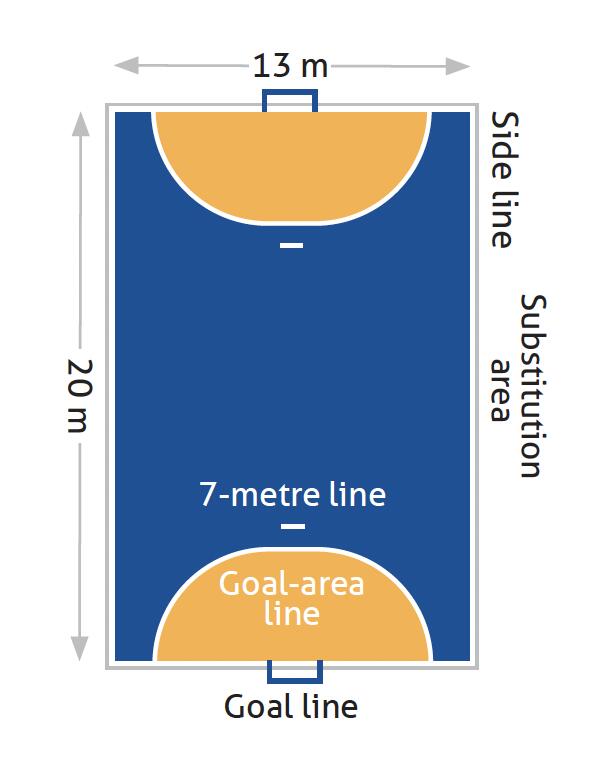Olympic Handball For Kids: The Rules Of Mini Handball & What Equipment You Need

Handball is a team-oriented sport that embodies the spirit of fair play. The game is straightforward to pick up, and you can quickly grasp the basics, starting with some fundamental rules.
Mini handball is a simplified version of Olympic handball, designed specifically for children. The game is played on a smaller court with fewer players, which helps children to engage more directly in the action and learn the fundamental skills of handball such as throwing, catching, and teamwork.
Summary of key information:
- Court Size: Mini handball is typically played on a smaller court, usually 20 meters by 13 meters, making it easier for young players to participate.
- Teams: Each team consists of four field players plus a goalkeeper.
- Goal Size: Goals are smaller, with dimensions around 2.4 meters wide by 1.6 meters high.
- Ball: Use a size 0 or 1 handball, which is smaller and easier for children to handle.
Mini Handball vs Olympic Handball
Mini handball differs significantly from Olympic handball in several ways to accommodate younger players:
- Court Size: Mini handball is played on a smaller court, making it easier for young players to move around and participate actively.
- Team Size: Teams are smaller, typically with 4 players plus 1 goalkeeper, which ensures that every player gets plenty of touches of the ball and involvement in the game. Within each team the players are interchangeable during the game without limitation.
- Game Duration: Matches are shorter, often divided into smaller periods, to maintain the attention and energy levels of younger players. The duration can be variable and games are played with two halves (7, 10, 12, 15 min, etc), with or without a break, with or without changing sides.
- Rules: The rules are simplified. For example, the physical contact allowed in Olympic handball is reduced or eliminated in mini handball to prioritize safety and enjoyment.
How to Play Mini Handball: Rules of the Game
The objective in handball is to score by launching the ball into the opposing team's net while defending your own from incoming shots. Victory goes to the team that nets the most goals by the conclusion of the match, as per the game's regulations.

The basic rules of mini handball:
- Scoring: The aim is to score goals by throwing the ball into the opposing team’s net. Each goal counts as one point.
- Gameplay: Players must pass the ball after a maximum of three steps and can hold the ball for only three seconds before passing or shooting, encouraging quick play and teamwork. Players can move with the ball by dribbling or passing to teammates.
- Man-Man Defence: Players engage in man-to-man defence rather than offensive or defensive positions.
- No Physical Contact: Emphasis is on skill development, not physical strength. Pushing, blocking, and aggressive play are discouraged.
- Goalkeepers: The goalkeepers defend the goals, and after a goal is scored, the game is restarted with a throw from the goalkeeper.
- After Scoring a Goal: A goalkeeper throw is used to restart the game.
- Substitutions: Players can freely substitute in and out of the game, allowing everyone a chance to participate and rest when needed.
Playing Environment
- Mixed Gender: Boys and girls play together, promoting inclusivity.
- Modified Goal Area: The goal area is smaller, generally 4 to 5 meters from the goal line, making it easier for children to shoot and score.
- No Free-throw Line: Simplifying the rules further, there is no marked free-throw line in mini handball.
Mini Handball Facilities
The facilities required for mini handball are minimal, making it an accessible sport for schools:
- Indoor or Outdoor: Mini handball can be played in a gymnasium or on any flat outdoor surface.
- Mini Handball Court Dimensions: The court measures 20 x 13 meters, with longer boundary lines called side lines, and shorter ones known as goal lines.
- Goal Area: The goal area is marked out in front of the goal line. It is defined by a goal-area line that can be a circle or a rectangle with a 4-meter radius for novices or a 5-meter radius for beginners.
- 7-Metre Line: 5 to 6 m from the goal.
- Materials for Marking: To mark a mini handball court, various materials can be used such as adhesive tape, chalk, sand, fabric line, plastic line, etc. Lines can also be created on grass surfaces with a mower or by excavating grooves.

Mini Handball Equipment
The equipment needed for mini handball is straightforward and inexpensive:
- Handball: Mini handball is played with a modified soft-skinned ball on a smaller court to help children safely learn the goalkeeper position. Use size 0 or size 1.
- Goals: Mini handball goals have a height of 1.6 metres and a width of 2.4 metres. Portable, lightweight goals are sufficient, and in many cases, existing facilities like soccer goals can be adapted for use in mini handball.

- Appropriate Clothing: Players should wear comfortable sports clothing and sneakers. Protective gear like knee and elbow pads can also be used for additional safety. For dividing the players during gameplay, when they do not have a uniform, we can use:
- Distinctive jersey, colourful training shirts.
- Collapsed sleeves, knot in the t-shirt.
- Coloured ribbon, adhesive tape, etc.
Mini handball is less about competition and more about learning the sport and enjoying it. Remember, the main goal is to have fun and encourage children to be active and engaged in the sport!
For more guidance for teaching mini handball, you can download the IHF Olympic Handball Guidebook here.





